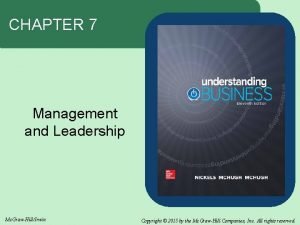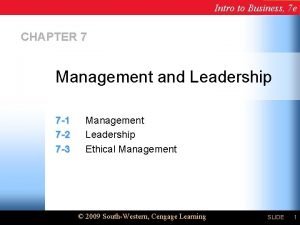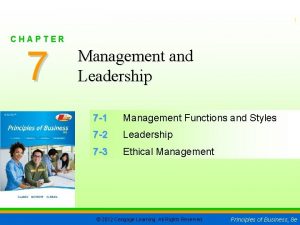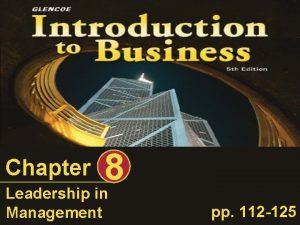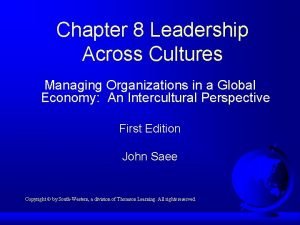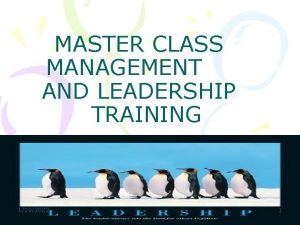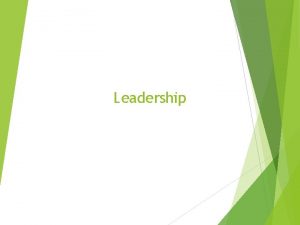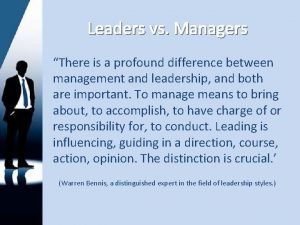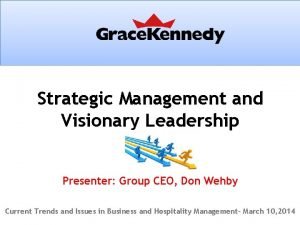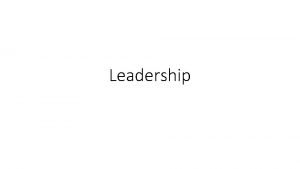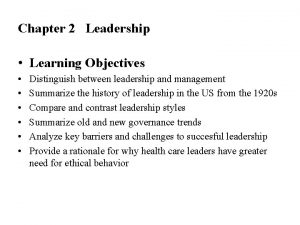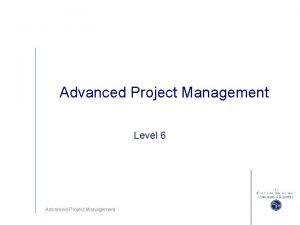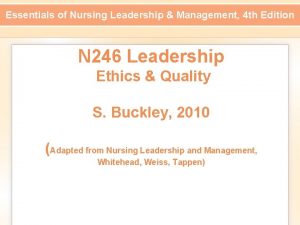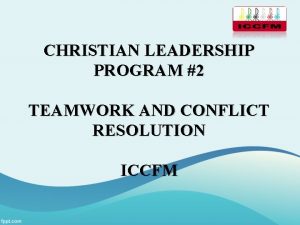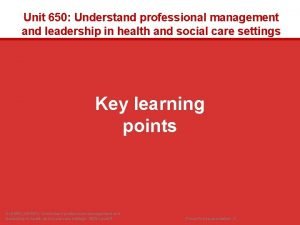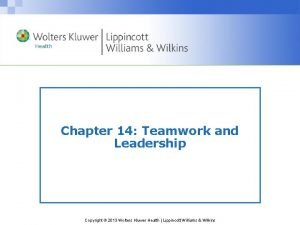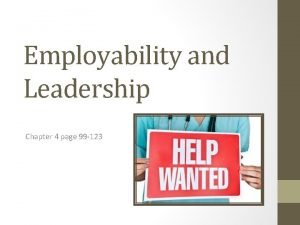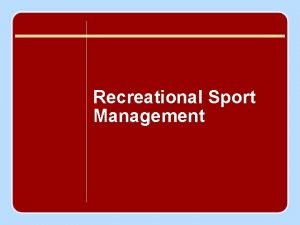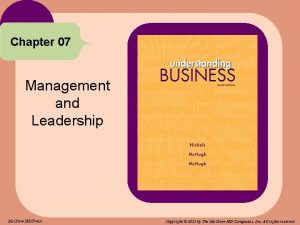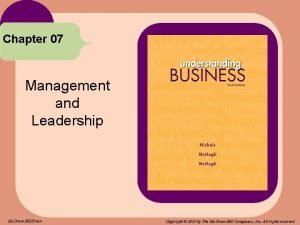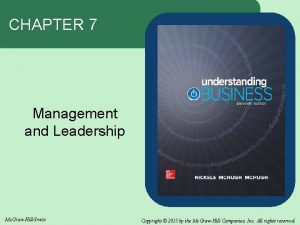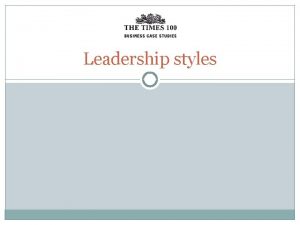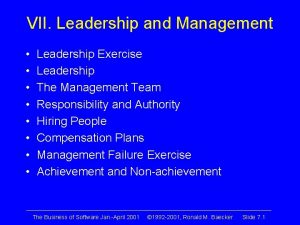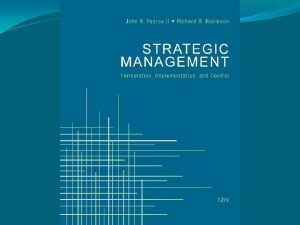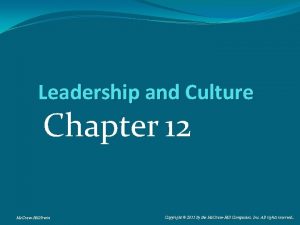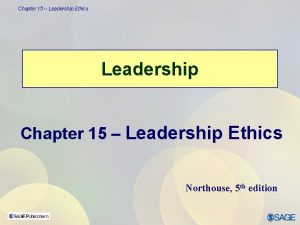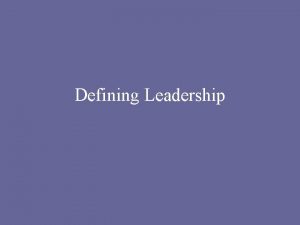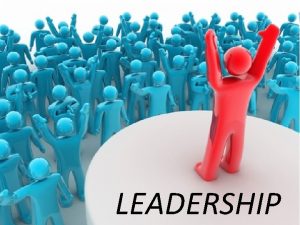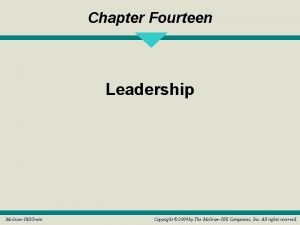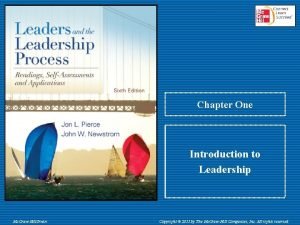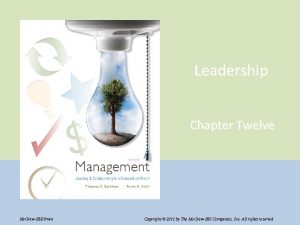CHAPTER 7 Management and Leadership Mc GrawHillIrwin Copyright






























- Slides: 30

CHAPTER 7 Management and Leadership Mc. Graw-Hill/Irwin Copyright © 2015 by the Mc. Graw-Hill Companies, Inc. All rights reserved.

WHAT IS MANAGEMENT? LO 7 -2 • Management -- The process used to accomplish organizational goals through planning, organizing, leading and controlling people and other organizational resources. 7 -2

TODAY’S MANAGERS LO 7 -1 • Younger and more progressive. - Growing numbers of women. - Fewer from elite universities. • Emphasis is on teams and team building. • Managers need to be skilled communicators and team players. 7 -3

FOUR FUNCTIONS of MANAGEMENT LO 7 -2 7 -4

FOUR FUNCTIONS of MANAGEMENT 1) Planning Process of establishing company goals and how to accomplish them 2) Organizing Process of structuring resources to carry out plans LO 7 -2 3) Leading Directing and motivating people to achieve organizational goals 4) Controlling Process by which managers measure performance and make sure the company’s plans and strategies are being properly carried out 7 -5

THE PLANNING PROCESS LO 7 -3 The first step in creating a strategic plan is to establish a corporate purpose • • Vision: what the business wants to be in the future; More than a goal, it’s a broad explanation of why the organization exists and where it’s trying to go Mission statement: a more current description of the organization’s purpose, basic goals, and philosophies; Outlines the organization’s fundamental purposes. It includes: - the organization’s self–concept its philosophy long–term survival needs customer needs social responsibility nature of the product or service Without knowing “what” you want to be, how can you properly set your goals and objectives? • Goals are broad, long-term accomplishments an organization wants to achieve within a certain time frame - in most companies, this is about five years • Objectives are the short-term targets that are designed to help achieve these goals 7 -6

PLANNING ANSWERS FUNDAMENTAL QUESTIONS LO 7 -3 • What is the situation now? SWOT Analysis -- Analyzes the organization’s Strengths, Weaknesses, Opportunities and Threats. • How can we get to our goal from here? - Strategic planning - Tactical planning - Operational planning - Contingency planning 7 -7

SWOT MATRIX LO 7 -3 7 -8

PLANNING FUNCTIONS LO 7 -3 7 -9

STRATEGIC and TACTICAL PLANNING LO 7 -3 • Strategic Planning -- Done by top management and determines the major goals of the organization and the policies, procedures, strategies and resources it will need to achieve them. • Tactical Planning -- The process of developing detailed, short-term statements about what is to be done, who is to do it and how. • Operational Planning -- The process of setting work standards and schedules necessary to implement the company’s tactical objectives. • Contingency Planning -- The process of preparing alternative courses of action the firm can use if its primary plans don’t work out. 7 -10

DECISION MAKING • LO 7 -3 Decision Making -- Choosing among two or more alternatives. What is the most important step? 7 -11

WHAT MAKES a GREAT CEO LO 7 -3 Decision Making Skills of Top CEOs • Keep global business issues in mind and be a citizen of the world. • Identify and manage risks before they grow. • Change strategies and models with the times. • Skillfully manage relationships with governments as government involvement rises. Source: Fortune, www. fortune. com, accessed November 2014. 7 -12

PROBLEM SOLVING LO 7 -3 • Problem Solving -- The process of solving the everyday problems that occur; less formal than decision making and needs quicker action. • Problem-solving techniques include brainstorming and PMI -- Listing all the pluses for a solution in one column, all the minuses in another and the implications in a third. 7 -13

ORGANIZING: FITTING TOGETHER THE PIECES OF THE PUZZLE LO 7 -4 Organizing: the process of structuring resources to carry out plans - Capital Personnel Raw materials Other resources 7 -14

LEVELS of MANAGEMENT • Top Management -- The highest level, consists of the president and other key company executives who develop strategic plans. • Middle Management -- Includes general managers, division managers, and branch and plant managers who are responsible for tactical planning and controlling. • Supervisory Management -- Those directly responsible for supervising workers and evaluating daily performance. LO 7 -4 • Chief Executive Officer (CEO) Introduces change into an organization. • Chief Operating Officer (COO) Implements CEO’s changes. • Chief Financial Officer (CFO) Obtains funds, plans budgets, collects funds, etc. • Chief Information Officer (CIO) Gets the right information to the right people so decisions can be made. 7 -15

AMERICA’S MOST POWERFUL FEMALE MANAGERS LO 7 -4 Rank Name Organization 1 Ginni Rometty IBM 2 Mary Barra GM 3 Indra Nooyi Pepsi. Co 4 Marillyn Hewson Lockheed Martin 5 Meg Whitman Hewlett-Packard 6 Irene Rosenfeld Mondelez International 7 Patricia Woertz Archer Daniels Midland 8 Abigail Johnson Fidelity 9 Ellen Kullman Du. Pont 10 Sheryl Sandberg Facebook Source: Fortune Magazine, www. fortune. com, accessed November 2014. 7 -16

MANAGERIAL SKILLS LO 7 -4 • Technical Skills -- The ability to perform tasks in a specific discipline or department (i. e. specific knowledge for the discipline). • Human Relations Skills -- Skills that involve communication and motivation; they enable managers to work through and with people. • Conceptual Skills -- Skills that involve the ability to picture the organization as a whole and the relationship among its various parts. 7 -17

SKILLS NEEDED at VARIOUS LEVELS of MANAGEMENT LO 7 -4 7 -18

THANK YOU LO 7 -4 The Most Basic Human Relations Skill • Saying “thank you” has led to happier employees and greater profits for companies. • Whom should a manager thank? 1. Interns - Doing lots of work for little money, they are the future of the company and industry. 2. Lawyers - Many do pro bono work, even for nonprofit companies. 3. The little people - Mailroom, repair, and cleaning staff keep the office running day-to-day. Source: Fast Company, www. fastcompany. com, accessed November 2014. 7 -19

STAFFING LO 7 -4 • Staffing -- Recruiting, hiring, motivating and retaining the best people available to accomplish the company’s objectives. • Recruiting good employees is critical. • Many people are not willing to work at companies unless they are treated well with fair pay. 7 -20

STAFFING is TRICKY BUSINESS LO 7 -4 Six Sins of Staffing 1. Don’t hire someone because someone else says so. 2. Don’t get caught up in applicants’ appearances. 3. Don’t give someone the wrong job. 4. Don’t forget about feedback. 5. Don’t give promotions just because it’s time. 6. Don’t cheat your employees. Source: Career. Builder, www. careerbuilder. com, accessed November 2014. 7 -21

LEADERSHIP LO 7 -5 • Leaders must: - Communicate a vision and rally others around that vision. - Establish corporate values. - Promote corporate ethics. - Embrace change. - Stress accountability and responsibility. 7 -22

ACCOUNTABILITY through TRANSPARENCY LO 7 -5 • Transparency -- The presentation of the company’s facts and figures in a way that is clear and apparent to all stakeholders. 7 -23

LEADERSHIP STYLES LO 7 -5 • Autocratic Leadership -Making managerial decisions without consulting others. • Participative or Democratic Leadership -- Managers and employees work together to make decisions. • Free-Rein Leadership -Managers set objectives and employees are free to do whatever is appropriate to accomplish those objectives. 7 -24

VARIOUS LEADERSHIP STYLES LO 7 -5 7 -25

NATURAL BORN LEADERS? LO 7 -5 Four Types of Executives Rationalists Humanists Politicists Culturists 7 -26

EMPOWERMENT LO 7 -5 • Progressive leaders give employees the authority to make decisions on their own without consulting a manager. • Customer needs are handled quickly. • Manager’s role becomes less of a boss and more of a coach. • Enabling -- Giving workers the education and tools they need to make decisions. 7 -27

WORK SMARTER LO 7 -5 How to Ease Pressure on Workers • Manage output instead of hours. • Train workers to be ready for a more complex corporate structure. • Allow lower-level managers to make decisions. • Use new technology to foster teamwork. • Shift hiring emphasis to collaboration. Source: Bloomberg Business. Week, www. businessweek. com, accessed November 2014. 7 -28

FIVE STEPS of CONTROLLING LO 7 -6 7 -29

ARE YOU a MICROMANAGER? LO 7 -6 • Do you have strategic initiatives that you have not addressed? • Do you often check on employees for quality control? • Do you often check on subordinates throughout the day? • Do you rarely take vacations? • Is there a lot of turnover? Source: CFO Magazine, www. cfo. com, accessed November 2014. 7 -30
 Transactional leadership vs transformational leadership
Transactional leadership vs transformational leadership Chapter 7 management and leadership answer key
Chapter 7 management and leadership answer key Introduction to business chapter 7
Introduction to business chapter 7 Chapter 7 management and leadership
Chapter 7 management and leadership Adaptive leadership characteristics
Adaptive leadership characteristics Adaptive leadership vs situational leadership
Adaptive leadership vs situational leadership Chapter 8 leadership in management
Chapter 8 leadership in management Chapter 8 leadership in management
Chapter 8 leadership in management Smooth running
Smooth running Master class management and leadership training
Master class management and leadership training Difference between leadership and management with examples
Difference between leadership and management with examples Leadership definitions
Leadership definitions Manager vs leader
Manager vs leader Dau cmmc
Dau cmmc Visionary leadership and strategic management
Visionary leadership and strategic management John kotter definition of leadership
John kotter definition of leadership Difference between leadership and management
Difference between leadership and management Maylor four stage model
Maylor four stage model Essentials of nursing leadership & management
Essentials of nursing leadership & management Classical views of leadership and management
Classical views of leadership and management Christian leadership and conflict management
Christian leadership and conflict management Learning points examples
Learning points examples Governance leadership and management
Governance leadership and management Management and leadership
Management and leadership Chapter 14 teamwork and leadership
Chapter 14 teamwork and leadership Employability skills vocabulary
Employability skills vocabulary Chapter 4 employability and leadership
Chapter 4 employability and leadership Scientific management
Scientific management Management pyramid
Management pyramid Top level management
Top level management Leisure sport management model
Leisure sport management model

